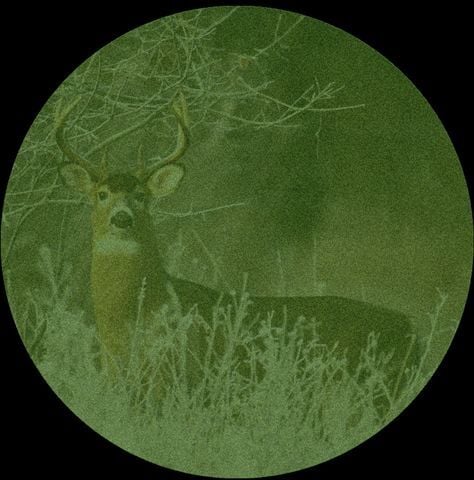Night vision devices, also known as residual light amplifiers, collect residual light from the moon, stars and/or an infrared lens.
Night Vision Generations
Night vision devices can be divided into three generations; 1st generation, 2nd generation and 3rd generation. Devices are divided into one of the three categories based on the strength of light intensifier technology.
1st Generation
The 1st generation night vision devices are both, the most common and most affordable night vision devices on the market. 1st generation devices can amplify the existing light up to 1000 times allowing you to see clearly in the dark.
It is possible for the observed image to consist of distorted edges, this is normal and is known as geometric distortion.

2nd Generation
The 2nd generation night vision devices are primarily used by law enforcement or professional purposes and are significantly higher in price. The 2nd generation night vision devices contain a micro-channel plate (MCP), which amplifies and releases thousands more electrons than the 1st generation devices. Due to this amplification, 2nd generation night vision devices generate a much brighter and sharper image in comparison to the 1st generation devices.
 3rd Generation
3rd Generation
Equipped with the latest night vision technology, 3rd generation devices produce the clearest and sharpest images available. The sensitive chemical composition of a special phosphor plate (Gallium Arcenide) ensures that these clear and sharp images are produced.
3rd generation night vision devices have a light amplification of between 30000 and 50000x, making them significantly dearer than the 2nd generation devices. Generally, 3rd generation night vision devices cost over € 5000, -.
Infrared
Residual light amplifiers use residual light from the stars and the moon however, some devices do not work in complete darkness. Due to this, all night vision devices are equipped with an infrared illuminator. This illuminator casts an infrared beam, which is invisible to the human eye, onto the area you wish to view (just like when using a flashlight). The night vision device recognizes the infrared illuminator and allows you to increase you viewing distance to ultimately view in complete darkness.
What is the Size of my Viewing Distance?
Several factors can influence the size of ones viewing distance. It is important to know what you wish to use the night vision device for. The larger the object, the easier it is to see. It is also import to think about how much detail you wish to see on the object. The detection range indicates the strength of the device, that is, the distance visible through the device. Obviously, the closer the object, the more detail you will be able to see.
Further, it is important to think about the amount of residual light available when you wish to use the night vision device. With much residual light, it is possible to see a lot further compared to the sole use of infrared in total darkness. For example, in an open field with plenty of moonlight or starlight, a house can be observed from an approximate distance of 500m whereas, in a forest with little residual light, an animal may only be able to be observed or detected at a distance of approximately 75m. Please see the table below for an indication of viewing distance in varying conditions.
When purchasing a night vision device, please remember that they cannot and shouldn’t be used for long distance observations such as riflescopes or binoculars. Night vision devices should purely be purchased to view objects.
| Viewing distance overview in meters at different influences | ||||
| 1st generation | Full Moon | Half moon | Starlight | Full darkness |
| Animal | 200 | 150 | 100 | 75 |
| Person | 250 | 200 | 150 | 100 |
| Car/Boat | 750 | 500 | 300 | 150 |
| 2nd generation | Full Moon | Half moon | Starlight | Full darkness |
| Animal | 300 | 225 | 175 | 100 |
| Person | 500 | 450 | 300 | 150 |
| Car/Boat | 1000 | 800 | 550 | 300 |
| 3th generation | Full Moon | Halve | Starlight | Full darkness |
| Animal | 400 | 300 | 225 | 150 |
| Person | 650 | 500 | 375 | 200 |
| Car/Boat | 1250 | 1000 | 800 | 550 |



